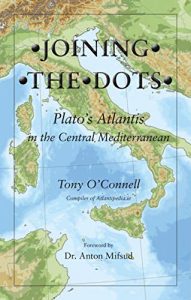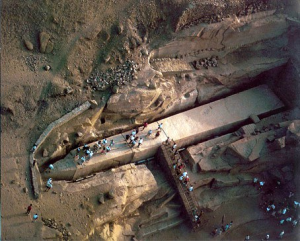ancient astronauts
Caspary, Nicholas
Nicholas Caspary published Plato’s Atlantis: On the Origin of Religion in March 2023 [2060], which according to the author is “intended as an update, a sequel, or a reboot if you wish, of Ignatius Donnelly’s 1882 work, and will as such be restating many of the same pertinent arguments as well as adding to his information that from our modern day.” For me, Donnelly’s ideas are now ‘old hat’ with little to offer modern Atlantis research and beyond resuscitation..
Nevertheless, Caspary spent the first half of his book reviewing Donnelly’s theories and then moved on to adding what he believes are more recent discoveries that support Donnelly. These include a change to the ice age cycle, the origin of our Moon as well as encounters with wandering extraterrestrial bodies.
Not content with a look at the evolutionary tree of humans, he then moves on to ancient astronauts, crystal skulls, Edgar Cayce, Orion Correlation Theory, etc, etc. He ends with a section on quantum physics, about which I and, I’m sure, most of my readers know very little. I was left with the feeling that I had just encountered a weird mixture of Däniken blended with Sitchin and Hancock that overall did little to justify Donnelly’s 19th-century speculations.
Leach, Shane
Shane Leach is an American writer who lives in Connecticut. He published Prehistory Explained [2007] as an ebook in May 2023 with the intention of proving ancient alien theory. I must be blunt and state that I consider the idea utter nonsense and have expressed my reasons throughout this compilation in particular in relation to Erich von Däniken, Zechariah Sitchin and ancient astronauts generally. In print, this Kindle book would fill over 700 pages offering an impressive triumph of quantity over quality.
The author’s introduction to the book tells you all you need to know about its content. “Prehistory Explained uses hundreds of pieces of irrefutable scientific evidence and hundreds of ancient writings to explain all the ancient mysteries. This book explores the following theories: Antarctica is the lost continent of Atlantis, the dinosaurs existed thousands of years ago not millions, ancient aliens left miles-high towers on the Moon, the Sapphire stone was a computer, Mars was inhabited in the ancient past, the Martian moon Phobos is an alien spacecraft, the Moon is an alien spaceship constructed by ancient aliens, ancient aliens directed panspermia by planting bacteria on the Earth, ancient aliens orchestrated the Cambrian Explosion, ancient aliens genetically-engineered us, and how the Anunnaki landed their X-Aerogel rocketships all over the Earth that have since depolymerized into stone pyramids.”
I therefore focused my attention on what is more relevant to this document, namely, Atlantis and found his offering sadly lacking.
Leach, along with regaling us with stories of ancient aliens and their spaceships also attempts to breathe new life into the Atlantis in Antarctica theory. He recycles the work of Rand Flem-Ath and Charles Hapgood and throws in the speculations of Richard Hoagland, but, for me, he fails to convince.
Overall the book is worth the $3 if only for its occasional comedic content.
Zaimi, Perparim *
Captain Përparim Zaimi is the Albanian author of the bilingual publication Atlantida – Perandoria e atlantëve dhe shqiptarët… / 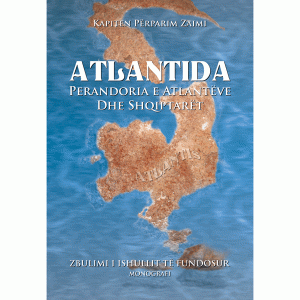 Atlantis – Empire of Atlanteans and Albanians: Discovery of Sunken Island published in 2013.
Atlantis – Empire of Atlanteans and Albanians: Discovery of Sunken Island published in 2013.
Zaimi wrote elsewhere “ The island of Atlantis with an area of about 400,000 Km2 (according to my calculations) sinks into the depths of the Atlantic Ocean and almost destroys the earliest and most advanced civilization that the ancient world has seen, always according to the explanations and stories left behind. Together with the Island of Atlantis, a giant land mass, in the shape of a peninsula of about 270 thousand km2, is separated from the Iberian peninsula and plunges into the depths of the Atlantic Ocean. The existence of this peninsula is discovered and mentioned for the first time by me in the scientific book Atlantis and the Empire of the Atlanteans.”(a)
For me, Zaimi’s credibility is completely undermined by his promotion of the idea of ancient extraterrestrial visitors.
(a) https://inforculture-info.translate.goog/2021/07/28/hartat-me-te-vjetra-te-planetit-toke-dhe-disa-spote-misterioze/ {Albanian) (There is a problem with translating this)
Mooney, Richard E. (L)
Richard E. Mooney was one of a number of authors who followed in the footsteps of Erich von Däniken with a couple ‘ancient astronaut’ books. His first, Colony: Earth[0842], has a chapter devoted to Atlantis in which he gives qualified support to the Minoan Hypothesis.
In his sequel, Gods of Air and Darkness[1078], he again touches on the subject of Atlantis, although in a slightly more muted fashion. Nevertheless, he refers to the Greek legends of Atlantis and Hyperborea as being “both obviously based on fact.” (p.183)
Drake, W. Raymond
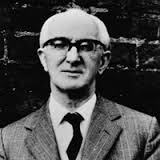 W. Raymond Drake (1913-1989) was a British writer who>was an ardent follower of Charles Fort, commenting that “I aspired to collect as many facts as possible from ancient literature to chronicle for the past what Charles Fort has so brilliantly done for the present century.”<
W. Raymond Drake (1913-1989) was a British writer who>was an ardent follower of Charles Fort, commenting that “I aspired to collect as many facts as possible from ancient literature to chronicle for the past what Charles Fort has so brilliantly done for the present century.”<
Drake began the publication of a series of books about ancient astronauts years before the better-known work of Erich von Däniken. From the start, Drake has included frequent references to Atlantis in his books. However, much of what he has written on Atlantis seems to have originated from the dubious outpourings of Blavatsky and Cayce. An example of his conclusions is “The Atlanteans probably developed electronic even telepathic techniques, radio, radar, television, for communicating with their armed forces, far-flung Empire and the near planets, the abode of their Teachers.” [1038.61]
Dodson, Frederick
Frederick Dodson is the author of Atlantis and the Garden of Eden[0989] and has published a number of
excerpts from it on his website(a). These deal with, the Basques, Berbers, Etruscans, Minoans and Guanches among other subjects. He also includes a commentary on ancient maps(c).
He has devoted much space in his book and his website to the mystery of very large megaliths, such as at Baalbek and the unfinished obelisk at Aswan(d).
What I read seemed fairly standard fare, but then in a second book[1657], he advanced into ‘ancient astronaut’ territory, at which point I parted company with him.
Even more hilarious is his The Pleiades and Our Secret Destiny[1658] in which he tells the story of his encounters with blue-skinned beings from the Pleiades!
Dodson is also self-promoted as a ‘reality creation’ coach(b). Hmm.
(a) https://www.ancient-atlantis.com/ (offline October 2017)
(b) https://www.realitycreation.org/
(e) https://www.realitycreation.org/ancient-aliens-of-atlantis/
Ancient Astronauts and Atlantis *
Ancient Astronauts and their technology is often promoted as the inspiration behind aspects of many ancient religions such as the vimanas of the Hindus, the flying chariots of Ezekiel as well as the gods of Mesopotamia. The most widely known proponents of these ideas are Erich von Däniken and the late Zecharia Sitchin.
However, I must also include Josef Blumrich who proposed that the biblical Ezekiel had encountered an alien spaceship in his 1973 book [0692]. It is worth noting that a decade earlier Arthur W. Orton wrote The Four-Faced Visitors of Ezekiel which was recently republished [1735] and offers similar ideas as Blumrich. Ulrich Magin has written a critical review of Bloomrich’s interpretation of Ezekiel’s visions(m).
Extraterrestrial visitors have been suggested by a few of the more imaginative and sometimes unscrupulous authors and their publishers, as the source of an advanced civilisation in the past, remembered today as Atlantis. Martin Brady makes such a claim in a brief paper available online(s).
Another example of this genre of b.s. is offered by Tricia McCannon, who delights us with an account of Atlantis as “the seat of a Great Galactic Empire, with many extraterrestrial races coming and going from its shores”, with lots more of the same(t).
Decades before von Däniken, Harold T. Wilkins was already suggesting prehistoric extraterrestrial visitors in the 1950s. He also wrote a couple of books about Atlantis[363][364]. Not long after that, Egerton Sykes wrote some short articles for his Atlantis magazine(i) that were sympathetic to the idea of ancient astronauts.
R. Cedric Leonard is another Atlantis researcher who has written about Atlantis and ancient alien technology. A more recent attempt to link Atlantis with ancient astronauts came from Kevin Falzon, who closely follows Sitchin while locating Atlantis in his native Malta[869]. Richard Mooney speculated on a connection between Atlantis and ancient aliens four decades ago[842].
However, Professor Emilio Spedicato may have added some degree of respectability to the concept when he wrote(u) “There are significant indications in worldwide traditions that intelligent people from planets within a few hundred light-years from Earth visited our planet and intelligently interacted with our biosphere”. He went on to claim that around 5500 BC some of these visitors landed in the Hunza valley of Pakistan where they engaged in a little genetic engineering which led to the ‘creation’ of Adam and Eve!
It should be noted that Plato’s account does not relate any technology beyond that of a Late Bronze Age society, whereas any civilisation founded by alien astronauts should offer some evidence of technologies at least equal to if not more advanced than that of our present-day capabilities.
Nevertheless, the idea of visitors from other worlds is often traced back to the 18th century and the writings of Emanuel Swedenborg (1688-1772)(e), who not only argued that extraterrestrial beings had visited our planet, but that he had met them[1583]! Greg Little has also recently(g) credited Swedenborg as the originator of the alien visitors’ idea, but Jason Colavito has rubbished Little’s article(f) and traced the concept of extraterrestrial encounters back to Lucian (125-180 AD) together with a few others before Swedenborg. Colavito and Little are not ‘best friends’, so I can only conclude that Colavito simply wished to undermine Little’s credibility as a researcher.
Ever since Kenneth Arnold saw ‘flying saucers’ near Mt. Rainier in 1947, his report paved the way for the ancient astronaut idea to evolve into the prolific writings of W. Raymond Drake and later Erich von Däniken, among others. In turn, this seemed to lead naturally to speculation of a possible linkage with Atlantis.
Jason Colavito has also drawn attention(a) to an exhibition held in Beijing in July 2012, which purported to offer evidence of these ancient visitors, and has published(b) the official U.S. Government view on ancient astronauts. He also offers an overview of alien theories and scathingly criticises their proponents(c). In 2011 Colavito published a free ebook with the self-explanatory title of The Origins of the Space Gods(j).
Colavito has also an interesting blog for 29/08/14 which quotes from a 1977 magazine that has an article suggesting that Jesus was an American astronaut who came back from the future, no doubt inspired by the film Planet of the Apes!(d)
Bill Hanson and Bert Thurlings are some of the more recent promoters of this idea of an alien origin for Atlantis. Hanson has been joined by the German researcher, Dieter Bremer, who claims(v) that the winged disks found in Sumerian art represent a space station, which crashed! Bremer also provides a spirited defence of The Manna Machine[755] by George Sassoon (1936-2006) and Rodney Dale, combined with some bizarre theories regarding Christ. Incredibly, Bremer was invited to deliver a paper to the 2011 Atlantis Conference on the concentric circles of Plato’s Atlantean capital. He has published two books on his view of Atlantis[1022/3]. A more rational review of The Manna Machine is offered by Frank Dörnenburg(w).
The late Flying Eagle and his partner Whispering Wind specified the planet Xylanthia((aa) in the Sirius star system as the original home of a visitor who fell in love with an earthling and later became known as Poseidon!
The History Channel’s series entitled Ancient Aliens(y) has been heavily criticised on the Bad Archaeology website(x) and elsewhere. October 2011 saw another claim that the Maya had contact with extraterrestrials and that a documentary providing evidence is planned(z).
A sceptical review of extraterrestrial visitations was published in the 26th January 2014 edition of Ohio’s Columbus Dispatch(ab).
I feel compelled to include a quote from the Calvin and Hobbes cartoonist Bill Watterson who wrote “The surest sign that intelligent life exists elsewhere in the universe is that they have never tried to contact us.”
Perhaps even more disconcerting is the results of a survey(h) carried out by Chapman University that show 20% of Americans believe in ancient astronauts!
In 2020, we had a bizarre tweet from the billionaire, Elon Musk, claiming that “aliens built the pyramids”(l), I hope that this was a tongue-in-cheek comment!
Nevertheless, there are still (2021) attempts to promote the ancient astronaut idea using the same material that has failed to convince in the past(k).
An example of this is the 2023 book, Prehistory Explained [2007] by Shane Leach, who recycled some of the ideas of von Däniken and Sitchin and then for good measure threw in the old suggestion that our Moon and the Martian moon Phobos are artificial. Of course, Atlantis was not ignored, which he placed in Antarctica and deemed that Stonehenge had been laid out like the Pleiades constellation!
More depressing is the study by Graham E.L.Holton, which surveyed the ancient astronaut literature and found nothing but superior white blond ‘gods’, usually male, such as Quetzalcoatl(n). This theme was continued in later UFO reports. Erich von Däniken is arguably the best-known of the ancient astronaut proponents, but he was not the first and certainly not the last(n). Jason Colavito has reviewed the racism expressed by von Däniken(o). Keith Fitzpatrick-Matthews was equally critical of Däniken’s racist views(p).
2023 also saw the publication of Gods of the Bible [2059] by Mauro Biglino, who also wrote a paper as ‘Author of the Month’ for Graham Hancock’s website(q). In both, he explores the Bible for evidence of ancient extraterrestrial visitors who interacted with humans, just as Zechariah Sitchin had done nearly half a century ago using Mesopotamian texts.
There are also some who have endeavoured to use the Palermo Stone as evidence of extraterrestrial visitors in our ancient past(r)!
Avi Loeb who is probably better known as a contributor to the Ancient Aliens TV series has recently (Nov. 2023) endeavoured to develop his ‘fame’, by offering by offering an alternative to the conventional theories offered to explain UFOs, now redesignated UAPs (Unidentified Anomalous Phenomena). Jason Colavito(ad) has drawn attention to an attempt by Loeb to suggest that UFOs, sorry, UAPs, might be remnants from a very early highly technologically advanced civilisation.
“Any technological infrastructure left on the surface of Earth from that early civilization could have been demolished by geological activity including subduction, covered by water or tarnished by meteor impacts and weathering.
However, functional relics could have been preserved in space. Within the past century of modern technology, our civilization has launched many thousands of functional devices in orbit around Earth. A more advanced or longer-lived technological civilization could have used more sophisticated devices. Are there unfamiliar technological relics in our sky?” (ac).
For those interested in having a look at other entries touching on the subject of Atlantis and ancient astronauts see: Jack Countryman, Christos A. Djonis, Andrew Greig, Kurt Jurgen Hepke, Marius Lleget, Louis Millette, Semir Osmanagic, Hubert Zeitlmair.
(a) https://www.jasoncolavito.com/1/post/2012/07/chinese-government-endorses-ancient-astronauts.html
(b) https://www.jasoncolavito.com/the-von-daniken-letter.html
(c) http://www.swans.com/library/art18/jcolav01.html
(d) https://www.jasoncolavito.com/blog/a-bizarre-1977-article-on-jesus-the-ancient-astronaut
(e) https://web.archive.org/web/20200731011955/https://www.swedenborgproject.org/2007/09/08/the-life-on-other-planets-question/ or See: Archive 2262
(g) https://apmagazine.info/index.php/component/content/article?id=570
(h) https://blogs.chapman.edu/wilkinson/2015/10/13/this-haunted-world/
(i) Atlantis, Volume 20, No.3, May/June 1967.
(j) https://www.jasoncolavito.com/origin-of-the-space-gods.html
(k) Evidence of Aliens and Ancient Astronauts – Strange Unexplained Mysteries (archive.org)
(m) Spaceship or God’s apparition? The Visions of Ezekiel – Mysteria3000 (link broken)
(n) https://www.academia.edu/30755438/Ancient_White_Astronauts_Race_and_Religion
(o) http://www.jasoncolavito.com/1/post/2014/01/the-astonishing-racial-claims-of-erich-von-daniken.html
(p) https://badarchaeology.wordpress.com/2014/01/12/is-pseudoarchaeology-racist/
(q) https://grahamhancock.com/biglinom1/
(r) Reddit – Dive into anything (archive.org)
(s) Earth, Aliens and The Universe | PDF | Atlantis | Calendar (archive.org)
(t) https://www.triciamccannon.com/dvd-time-travel-ufos-atlantis-and-world-changes/ (Link Broken) *
(u) https://atlantipedia.ie/samples/archive-2090/
(v) https://www.atlantisbremer.de/
(w) https://web.archive.org/web/20201021072640/http://fdoernenburg.de/alien/alternativ/manna/man01_e.php
(y) https://www.history.com/shows/ancient-aliens/episodes/season-3#slide-9
(z) Mayan Filmmaker Offers Photo as Proof of Aliens, Says Hawking Agrees (Exclusive) (archive.org)
(aa) https://atlantis-today.com/Great_Atlantis_Flood.htm
(ab) See: Archive 2098
(ac) https://avi-loeb.medium.com/are-uaps-relics-from-an-earlier-civilization-on-earth-86d1190c6539
Steiger, Brad *
Brad Steiger was born as Eugene Olson(b) in Fort Dodge, Iowa  in 1936. He is the author of over 150 books and thousands of articles on a variety of subjects, such as crime, spirituality, UFO’s and other unexplained phenomena. He has written three books[127][128][129] related to Atlantis, but in the main they are re-workings of old and sometimes questionable material. Steiger subscribed to the ancient astronaut theory and concluded that Atlantis can only be found at the bottom of the sea. His book, Atlantis Rising was republished in 2007.
in 1936. He is the author of over 150 books and thousands of articles on a variety of subjects, such as crime, spirituality, UFO’s and other unexplained phenomena. He has written three books[127][128][129] related to Atlantis, but in the main they are re-workings of old and sometimes questionable material. Steiger subscribed to the ancient astronaut theory and concluded that Atlantis can only be found at the bottom of the sea. His book, Atlantis Rising was republished in 2007.
He reiterated his belief in the ‘Sky People’ in a December 2012 interview(a).
In March 2016, it was announced by Nick Redfern that Steiger’s 1974 book, Mysteries of Time and Space, was to be re-released, which prompted Jason Colavito to write a brief but scathing review(c) of Steiger’s work. This prompted online exchanges between Colavito and Redfern.
Brad Steiger died May 6th 2018(d).
(b) https://kevinrandle.blogspot.ie/2015/05/arguing-over-trivia.html
(c) https://www.jasoncolavito.com/blog/brad-steigers-shopworn-mysteries-of-time-and-space
Aegean Sea
The Aegean Sea is located in the eastern Mediterranean, bounded by the Greek mainland in the north and west, Turkey in the east and extending to Crete in the south. In 1899, R.F. Scharff claimed that it was commonly accepted that the Aegean had been dry land until after the appearance of man(c). Zhirov wrote of this landmass being referred to as ‘Aegeida’ before it subsided to form the Aegean Sea [0458.96], but he doubted that it occurred before ‘thinking man’ arrived there.
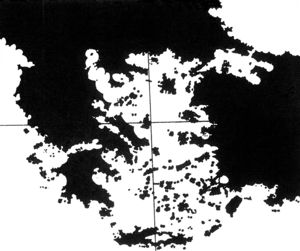 The 15th-century map of Ibn Ben Zara appears to show the islands of Aegean as larger and more numerous than today!
The 15th-century map of Ibn Ben Zara appears to show the islands of Aegean as larger and more numerous than today!
The importance of the Aegean to the ancient Greeks is highlighted by Plato when he described their relationship as one where the Greeks “are like frogs around a pond.” (Phaedo 109a-b)
However, it has been noted(i) that the Homeric poems (and the works attributed to Hesiod) studiously avoid any reference to the Aegean Sea, an avoidance that appears all the more striking when juxtaposed with the fact that there are other named seas in the poems.
A 280-page overview of the Aegean civilisations from the Neolithic to the Hellenistic period(f) is worth a look.
It can be reasonably argued that initially, the Greeks had little knowledge of the world beyond the Aegean, which might explain why Plato did not seem to know the exact identity of the Atlanteans. In this regard, a quote from an AtlantisOnline forum seems relevant – “There is evidence, moreover, that the Greeks were restricted by the Phoenicians to the Aegean Sea for a period of many centuries from 1200 BC onwards, and Naval Historians attribute this to the availability exclusively to the Phoenicians of two elements in ship construction, namely long straight cedar timbers (compared to short sinuous olive timbers available to the Greeks) and Bronze for fixings, claddings and battering rams, which were used in battle to perforate hulls, sinking the enemy.”(e)
Many researchers have suggested the Aegean as a possible location for Atlantis with Thera and Crete as the leading contenders. In fact, it is Thera, with its dramatic volcanic eruption, in the middle of the second millennium BC that still  manages to command considerable support after nearly one hundred years since it was first mooted. Its advocates view it as the most likely source of inspiration for Plato’s tale, in spite of the fact that it conflicts with many of the details described by him.
manages to command considerable support after nearly one hundred years since it was first mooted. Its advocates view it as the most likely source of inspiration for Plato’s tale, in spite of the fact that it conflicts with many of the details described by him.
One regular blogger, ‘mapmistress’, proposed (2010) that the Pillars of Heracles were situated at Rhodes with Atlantis situated north of the island in the Aegean. This suggestion is based on the claim that all English translations of Timaeus 24e are ‘botched’ and that the original does not say “larger than Libya and Asia together” but instead should read “north of Libya and west of Asia”! In fact, she goes further with the claim that the very word ‘Atlantis’ was invented by Benjamin Jowett!(d)
Three Italian linguists, Facchetti, Negri, and Notti, presented a paper to the Atlantis conference on Melos outlining their reasons for supporting an Aegean backdrop to the Atlantis story. Another paper was presented by four members of the Hellenic Centre for Marine Research which demonstrates how three-quarters of the Cyclades Plateau was submerged between 16000 BC and 6000 BC as the sea levels rose after the last Ice Age. Kurt Lambeck and Anthony Purcell also presented a paper along similar lines.
>However, not everyone is happy with Atlantis being placed in the Aegean. About 20 years ago an anonymous contributor to the now-defunct geocities website wrote the following piece regarding the matching of Atlantis with the eruption of Thera(o).
“To arrive at this conclusion is simple enough – take the numbers Plato uses for the dimensions and antiquity of Atlantis, divide them by ten, then keep all the fabulous details about the architecture and pretend it applies to the structures and artifacts recovered by archaeology – then throw out all the details about its conquering armies, its location, and its complete disappearance. No wonder there’s such an exact match!”<
Paulino Zamarro has offered a very radical theory, outlined in his book [024], which claims that Atlantis was located in the Aegean, with its capital on Melos, at a time when sea levels were lower and the islands more extensive in area, with some of them joined together. He postulates an isthmus or land bridge between Gibraltar and Morocco, which he believes was breached around 5500 BC. An idea supported by Strato and Seneca. He contends that this breach not only flooded the Aegean but also was also responsible for the subsequent inundation of the Black Sea, which until then was a smaller freshwater lake.
Diamantis Pastras, a Greek-Australian confectioner presented to the Atlantis Conference in 2005 [0629.295] his theory that Atlantis had been situated in the Aegean Cyclades along with nearby Astipalea in the Dodecanese, which he maintains constituted a single larger landmass 3,500 years ago.
Recent studies have revealed(b) the extent of very early seafaring in the Aegean can be pushed back to around 10,000 BC with evidence of obsidian trading at that period. However, the lower sea level at that time would have meant that the Aegean islands would have been much larger with shorter distances, if any, between them, so it may be unwise to read too much into the obsidian evidence.
A 2018 article pushes back Mediterranean seagoing even further(h). Consider how this evidence may relate to Plato’s comment that when Atlantis was established “at that time neither ships nor sailing were as yet in existence” (Crit.113e). However, December 2022 brought a claim of even earlier seafaring in the Aegean, possibly as far back as 450,000 years ago, according to a team from the University of Patras in Greece led by George Ferentinos(n).
In 1998 William Ryan and Walter Pitman published[025] their evidence for the enlargement of the Black Sea with seawater. The book received widespread attention that led to a subsequent expedition to the area by Robert Ballard, the famous discoverer of the Titanic.
However, Zamarro’s ideas have received very little notice, probably because he has only been published in Spanish. His theory regarding the silting and closure of the mouth of the Mediterranean deserves further consideration, as its confirmation would have a profound effect on the course of future studies of the prehistory of the region and in particular Atlantology.
C.C.M. Hardy was a regular contributor to Sykes‘ Atlantis journal, in which he suggested that remnants of Atlantis would be found in the seas around Greece. Hans-Henning Klein favours the island of Samothrace in the northern Aegean as the home of Atlantis(l).
A half-hearted attempt to link the Greek island of Thasos with Atlantis is to be found on the German de.pluspedia.org website(j).
A recent recruit to the ‘Atlantis in the Aegean’ camp is Christos A, Djonis with his theory[935] that Atlantis lay in the Aegean Sea, to the north of Thera, which itself contained the capital city of the Atlantean confederation. He makes no reference to Zamarro, who proposed a similar location fifteen years ago and consequently, considers Djonis’ work as a form of plagiarism! Apart from that, my gripe is that Djonis wastes over half his book discussing UFOs and ancient astronauts. Another proponent of a Theran Atlantis is Elias Stergakos, who also published his short book[1035] on the Minoan Hypothesis in 2014.
In the same year, the Italian architect Costa Kyrki published a paper entitled Lost Atlantis in which he proposed that the sunken Atlantis was situated between the island of Samos and Miletus on mainland Turkey(k).
J.P. Rambling on his Redefining Atlantis website(g) has now added his support to the concept of an Aegean Atlantis, situated on a large landmass, now mostly submerged, and which included what is now Santorini.
It is worth noting that Jürgen Spanuth In defending his North Sea location for Atlantis scornfully denounced the possibility of an Aegean Atlantis in Atlantis of the North [015.247]. “Neither Thera nor Crete lie in the ‘Atlantic sea’ but in the sea of Crete, which is clearly referred to in Crit.111a and is obviously not the Atlantic sea of Tim.24. Neither island lies at the mouth of a great river; neither was ‘swallowed up by the sea and vanished’ (Tim.25d): the Aegean never became ‘impassable to navigation’ (ibid.) Solon and Plato could never have said of the Aegean that passage there was hindered by ‘impenetrable mud’ (Crit.108e) for both had sailed through it – their contemporaries would have laughed at them if they had made such an absurd assertion.” Spanuth failed to highlight that Plato referred to the shoal of mud in the present tense indicating that it was still a hazard in his day!
What I cannot understand is that if Atlantis had existed in the Aegean, why did Plato not simply say so?
The Atlantisforschung website offers a selection of articles dealing with many aspects of the Aegean and its possible connection with Atlantis(m).
(a) https://atlantipedia.ie/samples/document-250811/
(b)https://www.stonepages.com/news/archives/004698.html
(c) https://www.gutenberg.org/files/33236/33236-h/33236-h.htm#Page_61
(d) https://pseudoastro.wordpress.com/2009/02/01/planet-x-and-2012-the-pole-shift-geographic-spin-axis-explained-and-debunked/ (about half way down page)
(e) https://atlantisonline.smfforfree2.com/index.php?topic=3238.1260
(f) https://www.slideshare.net/darkyla/greeks-9775861
(g) https://redefiningatlantis.blogspot.ie/
(h) https://www.sciencemag.org/news/2018/04/neandertals-stone-age-people-may-have-voyaged-mediterranean
(j) Atlantis Verortung in der Ägäis (Thasos) – PlusPedia
(k) https://www.behance.net/gallery/17045455/LOST-ATLANTIS
(l) ATLANTIS ERAT ! – Es gab ATLANTIS! – Samothrake ist Atlantis – Atlantisforschung.de
(n) Ancient Humans May Have Sailed The Mediterranean 450,000 Years Ago : ScienceAlert
(o) Sunken Civilizations — www.geocities.com/sunkenciv/index.html (archive.org) *
Däniken, Erich von
 Erich von Däniken (1935-) is famous for his ancient astronaut theories. However, others, such as W. Raymond Drake preceded him. Similarly, George Hunt Williamson (1926-1986), who also wrote of alien visitors, was irked by Däniken being referred to as “the father of the ‘ancient astronaut’ theory”(g).
Erich von Däniken (1935-) is famous for his ancient astronaut theories. However, others, such as W. Raymond Drake preceded him. Similarly, George Hunt Williamson (1926-1986), who also wrote of alien visitors, was irked by Däniken being referred to as “the father of the ‘ancient astronaut’ theory”(g).
As a young man, I was influenced by Däniken’s writings and it took time to develop my critical faculties to the point where I could discount his ideas as ‘pure waffle’. I now see him as a guru for the lunatic fringe who cynically presents distorted collections of historical artefacts and data for financial gain.>One website(a) recounts his claim that the humble banana is evidence of extraterrestrials visitors.<The same source also deals with his lack of truthfulness, which along with one particular blog(c) from Jason Colavito are both well worth a read. Colavito has also reviewed the racism expressed by von Däniken(d).
Von Däniken had seldom touched on the Atlantis story until his Odyssey of the Gods published in English in 2000[273]. He concentrated his discussion on the work of fellow Swiss writer, Eberhard Zangger, who identifies Atlantis with Troy. Von Däniken appears ambiguous about the actual existence of Atlantis, although he seems most reluctant to accept Zangger’s Trojan theory.>“Almost anything is possible where Atlantis is concerned. Only Eberhard’s assumption that Atlantis was nothing other than Troy is hard to sustain.”<
Von Däniken joined the many 2012 opportunists in his 2010 offering Twilight of the Gods. He claims that 2012 will not see the end of the world but in fact, the Mayan ‘prophecies’ relate to the return of the ‘gods’ in the form of alien astronauts. I hope Von Däniken meets them and expresses his gratitude for the good living that they have provided him with for nearly half a century.
Jason Colavito offers an extensive 7-part critique of ‘Twilight’. Colavito is also featured in Issue 8 of the English magazine Explore History which reviews 50 years of ancient aliens a la von Däniken. The article includes a number of references to Colavito’s criticism of Däniken’s theories(f).
E.C. Krupp, director of the Griffith Observatory in Los Angeles offers a highly critical review of von Däniken’s astronomical knowledge [1842.247]. However, in a balanced conclusion, Krupp candidly wrote “it would be very difficult to prove that ancient astronauts did not visit the earth. But evidence for their having been here is not convincing.”
Some of Daniken’s books are now available as free pdf files(e).
(a) Erich von Daniken: Fraud, Lies and Bananas – Skepticism (paranormalknowledge.com) *
(b) https://www.jasoncolavito.com/1/category/ancient%20astronauts/1.html
(d) https://www.jasoncolavito.com/1/post/2014/01/the-astonishing-racial-claims-of-erich-von-daniken.html
(e) https://epdf.tips/miracles-of-the-gods-a-new-look-at-the-supernatural.html
(g) George Hunt Williamson and the ‘Brotherhood of the Seven Rays’ (bibliotecapleyades.net)
